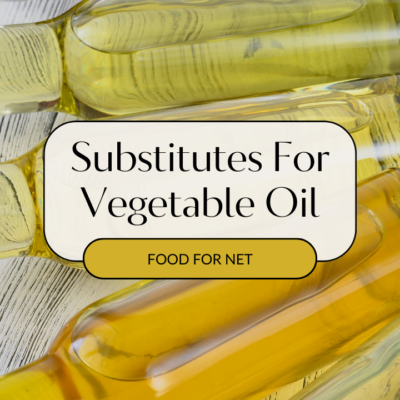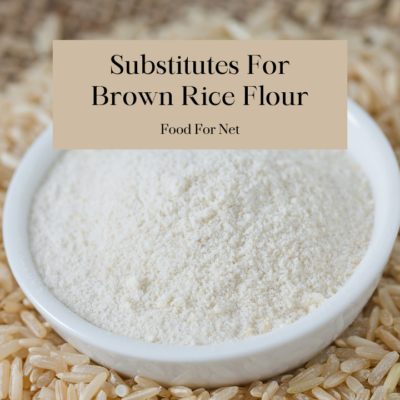
Baking soda is a crucial staple for anyone who bakes regularly. Baking soda and baking powder both help to make your baked goods soft and fluffy. Without one or the other, you risk ending up with dense baking that doesn’t go down well.
If you bake regularly, you probably have an ample supply of baking powder and baking soda in your cupboard (you need both, as they function differently and are relevant for different recipes). But… what if you run out? Or if you only bake occasionally? Those cases may call for substitutes for baking soda rather than the real deal.
Thankfully, there are some baking soda substitutes you can try, including baking powder, baker’s ammonia, and self rising flour. However, we’re not talking about straightforward substitutions here. Baking soda has very specific properties that most products can’t replicate precisely.
As a result, your baking may turn out quite differently depending on the substitute you use. There may also be some recipes that simply don’t work unless you have baking soda. In fact, if you’re going to experiment with substitutes, stick with relatively simple recipes, like muffins, cookies, and pancakes. Here, any leavening differences won’t have such a dramatic effect.
Substitutes For Baking Soda
Baking Powder

Baking powder is the obvious substitute, as both powders use an acid-base reaction to create carbon dioxide and leaven your baking. However, they’re not the same.
Notably, baking powder contains a weak acid, a base, and a buffering agent. The powder is simply activated by getting it wet. There is even double acting baking powder, which has two reactions and is perfect for recipes that need to rise as they are baked.
Baking soda is just a base. Because of this, your recipe needs an acidic ingredient to create the desired reaction. Don’t imagine this makes baking soda inferior. Baking soda is even sometimes a better choice, depending on the acidic ingredients in your recipe and when they’re added.
While these two ingredients are very different, you can sometimes use one instead of the other.
In particular, you can often use baking powder in a recipe that calls for baking soda (the reverse substitution is more complicated). This works because baking powder already contains baking soda.
To make the substitution, you need to play with ratios. You’ll need roughly three times as much baking powder as there was baking soda in your recipe (because of the buffer agent and acid in baking powder). This means using three teaspoons of baking powder instead of the teaspoon of baking soda your recipe originally called for. You should also drop out any salt, as baking powder often includes a little salt.
Pay attention to any acidic liquids in your recipe, like lemon juice. It’s often best to replace these with non acidic versions, like water, to prevent unexpected reactions. After all, your baking powder already contains acid, so you don’t need more. Bear in mind that the extra ingredients in baking powder may change the flavor and texture of your baking.
Baker’s Ammonia

Baker’s ammonia is an old-fashioned leavening ingredient that was used by bakers before baking soda and baking powder became popular. It is still used in some old fashioned recipes, especially as it can make cookies crispier than normal. In fact, for some thin cookies, baker’s ammonia creates a better texture than any other ingredient.
The chemical name here is ammonium bicarbonate. At high temperatures, baker’s ammonia breaks down into water, carbon dioxide, and ammonia, which all have leavening properties.
This substitution is best in low moisture recipes, especially crackers and cookies. It doesn’t work well in cakes because the ammonia isn’t able to escape and remains in the batter. This then gives the cake a bitter and soap-like flavor.
If your recipe is suitable, you can simply replace the baking soda in your recipe with an equal amount of baker’s ammonia. Still, while baker’s ammonia is easy to use, it isn’t that practical as a substitution. After all, if you don’t have baking soda in the cupboard, you’re not likely to have baker’s ammonia either.
Potassium Bicarbonate

Potassium bicarbonate is sometimes used as a dietary supplement, so there’s a chance you have some in your cupboard. If so, this is an easy substitute for baking soda, as baking soda is just potassium bicarbonate anyway.
The only difference is that baking soda generally contains salt as well, while potassium bicarbonate doesn’t. So, to get the right flavor, you’ll need to add some salt. Exactly how much will depend on the recipe. Try starting with around 1/4 teaspoon of salt for every teaspoon of potassium bicarbonate and experiment from there.
People trying to cut down their sodium could even skip the salt and just use potassium bicarbonate. Just remember that doing so will change the flavor of your recipe, potentially making it less appealing.
Self Rising Flour

Self rising flour contains flour, baking powder, and salt. So, if your recipe calls for flour and baking soda, you can skip the baking soda and use self rising flour instead of regular flour.
Some work with fractions is required to figure out how much self rising flour to use. In particular, each cup of the flour contains roughly 1 1/2 teaspoons of baking powder, which is equivalent to 1/2 teaspoon of baking soda.
You’ll also need to think about the amount of liquid and flour in your recipe. For example, some recipes might require you to increase the flour content, so that you get enough baking powder. Doing so would then make the recipe too dry and could mess with other aspects.
If you’re considering this flour, start by calculating the amount of self rising flour you’d need to replace the baking soda in your recipe. If this is dramatically different than the amount of flour in your recipe, you might need to try a different substitute.
Club Soda

The substitutions we’ve talked about thus far are the best ways to replicate the effects of baking soda. They also have a big problem – they’re not always that helpful. After all, if you don’t have baking soda in the cupboard, you probably don’t have baking powder or self-rising flour either. Baker’s ammonia and potassium bicarbonate are even less likely options.
So, you might need more creative substitutions, like club soda. The bubbles in the soda come from carbon dioxide, giving them some of the same effect leavening effect as baking soda.
The catch is that the bubbles don’t last long, so you’ll need to move quickly. The effect isn’t as dramatic as with baking soda either. As such, this substitution is best for simple recipes, like pancakes.
Remember that using club soda means you’re adding extra liquid to the recipe. You’ll need to decrease the liquid elsewhere in your recipe to make up for this. This substitution is also best for recipes that call for at least 1/2 a cup of liquid. Club soda isn’t a great fit for recipes that include less liquid than this.
Whipped Egg Whites

When you whip egg whites, you’re mixing tiny pockets of air into the eggs, making them fluffy. This effect lightens the eggs and any recipe that relies on the eggs. The leavening effect here isn’t as powerful as some of our other options, but it’s still better than nothing.
If your recipe already calls for eggs, separate the whites and the yolks out, then whip the whites before you add them. If there aren’t any eggs, just add egg whites and decrease the liquid in your recipe by the appropriate amount.
Either way, you’ll need to fold the egg whites in gently when it’s time to use them. Don’t overmix or you’ll break up the air pockets and lose most of the leavening effect. Adding the egg whites as one of the last ingredients makes this easy to do.
Whipped Cream

Like whipped egg whites and club soda, whipped cream doesn’t add a dramatic amount of lift (a bit more than club soda, but a bit less than egg whites). Still, the addition is fine for recipes that are pretty simple.
There’s also the flavor to think about, as whipped cream is sweeter than baking soda and most other substitutes. While this is fine for sweet recipes, it could be a problem for savory ones.
Also think about the amount of baking soda called for in the recipe. If it only needs a little, you won’t need to add much whipped cream and the flavor impact won’t be as dramatic.
Which Baking Soda Substitutes Are Right For You?
Best Baking Soda Substitutes For Pancakes
Pancakes don’t require much leavening, so most of the options on this list will work fine. You can even use club soda when making your pancakes. Just make sure you adjust the recipe to account for the extra liquid.
Best Baking Soda Substitutes For Cakes
Potassium bicarbonate is the most powerful option for cakes, as it’s basically baking soda anyway. You could also try baking powder, provided you get the quantities right. However, because cakes are complicated and rely heavily on leavening agents, they may not turn out quite right with baking powder. Other substitutes are even less likely to be effective.
For cakes, it’s normally best to avoid substitutes entirely. Just wait until you can buy baking soda instead.
Best Baking Soda Substitutes For Cookies
Some cookies turn out fine even without baking soda, so you can use whatever substitution you like. Baker’s ammonia is an especially good choice for thin cookies. It’s the only substitution that’s likely to produce better outcomes than baking soda.
If your cookies are complex and leavening is crucial, then you’ll need one of the more robust substitutes, like baking powder or self rising flour.
Baking Soda Alternatives For Cleaning
We’ve been focusing on one specific angle – baking soda as an ingredient. However, baking powder is surprisingly effective for cleaning as well. For cleaning, it isn’t the leavening properties you’re interested in, so you have different options for substituting.
In particular, combining borax and vinegar has many of the same effects as baking soda and vinegar, making it a great starting point. You can also simply use white vinegar for cleaning. The vinegar works best in a spray bottle and can be diluted if it is too intense on its own.
You can also use a little toothpaste for scrubbing-based cleaning. Many toothpastes actually have a little baking soda in them anyway.
Can You Skip Baking Soda?
Baking soda is a required ingredient in many recipes and leaving it out entirely simply won’t work. There are exceptions though. In particular, you can leave baking soda out of specific simple recipes, including pancakes and some cookies.
Doing so will noticeably change your baking, leading to flatter and denser treats. Still, for some recipes, the effect isn’t dramatic.
For more complex recipes, like cakes and bread, skipping baking soda isn’t a good idea. You’ll end up with something very dense that doesn’t taste good at all. If you’re an experienced baker, you may already have a sense of which recipes will work without baking soda and which require it. Novices may need to guess and experiment instead.
But, honestly, it’s much better to wait until you actually have baking soda. Otherwise, you risk all your hard work going to waste.

















 What To Serve With Ribs
What To Serve With Ribs